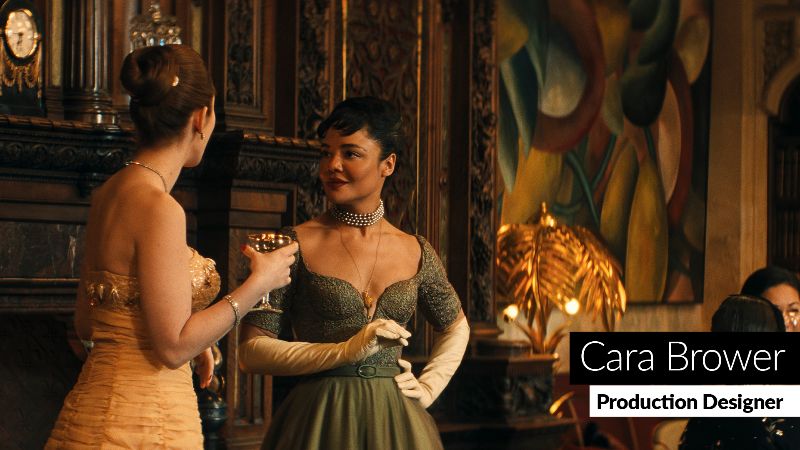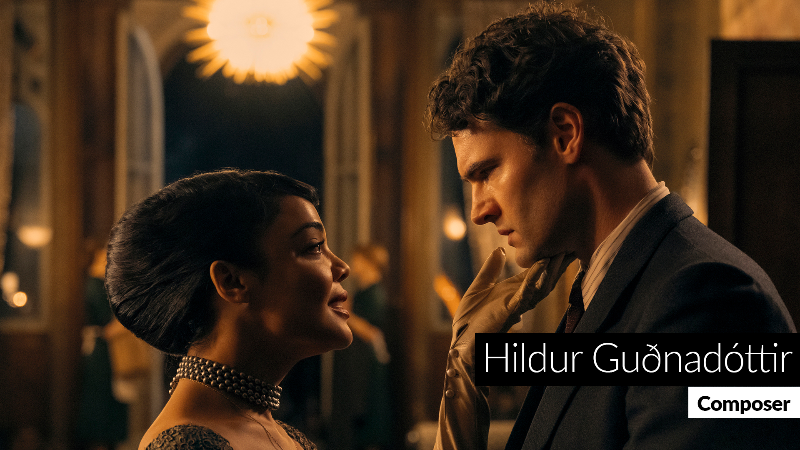Nia DaCosta‘s adaptation of Henrik Ibsen’s play, “Hedda Gabler,” trades the stormy skies of 19th century Norway for the shiny Mid-Century veneer of post-war England in no small part because the latter is more recognizable to contemporary audiences — and a lot more fun. The film version gets to see, and indeed to revel, in the party thrown by noted society chaos gremlin Hedda (Tessa Thompson) and the fallout in her heart and others as a result of her whims over the course of the evening.
It was incumbent, therefore, on every department working on “Hedda” to bring that sense of fun and barely controlled chaos to the proceedings. As anyone who has ever thrown a party knows, even joyful work is work. It required all departments to pull together, even to the point that “Hedda” composer Hildur Guðnadóttir enlisted background actors and production office workers to voice the breathy choir that seems to guide Hedda’s impulses. Every choice, from dress colors and pocket squares to the art deco shapes of the furniture to the set list for the in-film band, had to immerse the viewer in Hedda’s unstable, but magnetic, psychology.
“ I wanted it to feel like you were stepping into, as soon as you stepped into that house, you were stepping into sort of a vortex — Hedda’s vortex, where she is the master of all her schemes and designs, and it’s a little bit inescapable,” production designer Cara Brower told IndieWire.
In the videos below, watch how Brower, costume designer Lindsay Pugh, and composer Hildur Guðnadóttir work together to build a rotten but still alluring world of impulse and desire, the kind only Hedda herself would want to live in.
The Costumes of ‘Hedda’

For a lot of departments, a film that takes place in one location, mostly all over the course of a single day and night, can simplify their work. But it meant that costume designer Lindsay Pugh had to make every clothing item count and be instantly, visually expressive of the characters in “Hedda” — no one more so than Hedda herself, who strides down the ancient staircase through the lacquered ballrooms of her house in a dress that physically causes others to make way.
Pugh told IndieWire that having the time to develop a single costume she knew would be seen and used to its fullest advantage was a rare treat — maybe not as rare as a boozy nighttime swim on an English estate, but close enough. Even though Hedda spends most of the film in that imperious green dress, Pugh made sure to contrast it with what she wears before and what everyone else wears around it.
“Right at the very beginning, in her day costume, it was a very neat, tight-fitting, also very ’50s dress with sort of a show of a skirt to it. It was all just very neat and figure-hugging. So it was the perfect opportunity to then go into a proper ’50s corseted, cinched waist [dress] with a huge skirt so she could take up space in her party and everybody had to move away from her because of this fabulous, fabulous dress she was wearing.”
In the video above, watch how Pugh used costume design to set Hedda apart, and make her feel alone among a crowd.
The Production Design of ‘Hedda’

Scripts are always the blueprint of a film, even if pieces of it don’t make it to the final build. Along with Pugh, production designer Cara Brower was inspired by a moment in DaCosta’s script that never quite made it to shooting: a beat where Hedda takes a bite into a piece of fruit, and finds it rotten.
As disconcerting as that might be to actually see, the idea of ‘rotten fruit’ provided an inspiration for Brower’s approach to color and interior design of Hedda’s house, along with the research she did on socialites of the period. “Lindsay and I both picked up on that [rotten fruit] passage in the script. The camera was meant to go close up on it. And so that, to me and to Lindsay, was such an evocative visual metaphor for how we thought the color palette of ‘Hedda’ should be shaped,” Brower said. “Just tweaking all the colors and making them more moody, more desaturated, we wanted it to feel a bit claustrophobic in there.”
The color choices are a depature from the actually famous/infamous changes made by women like Lee Radziwill and Oonagh Guinness, but Brower felt they’d fit for Hedda. There’s a lot of darkness behind why she wants to put her own stamp on the house her husband George (Tom Bateman) buys for her and throw a middle finger up at what little history she has, in her father the General.
In the video above, watch how Brower juggled art styles and historical influences to build Hedda the home of her dreams — but a dream that’s exquisitely uncomfortable to live in.
The Music of ‘Hedda’

Nia DaCosta and Hildur Guðnadóttir had wanted to work together for a while. They are, after all, both theater girls. With “Hedda,” Guðnadóttir was delighted to be able to really work a theatrical approach into the music and, at the same time, use music to help solve the common play-adaptation problem of a dialogue-heavy story feeling “too stagey.”
Guðnadóttir’s assignment was to bring as much energy and life into the story as she could. Having a diagetic swing band certainly helps with that, and Guðnadóttir took some lyrics DaCosta wrote and turned them into the main dance number of the film, as well as extrapolated it out into the main instrumental love theme for Hedda. But for as much delightful jazz as there is in “Hedda,” Guðnadóttir really moves the story through her use of percussion and breath vocals.
“I had just finished reading this book about breath, and Nia was finishing this Samuel Beckett play about breath, so we felt like we wanted to have some sort of breath element to it,” Guðnadóttir told IndieWire. “ I brought the cast and the crew together on set — the women in the production office and some extras from the cast and a gaffer, the dolly operator, whoever was available at the time from the production to come and sing and breathe together. So all the voices you hear in the film and all the breathing, all the singing, come from the cast and the crew. I thought it was such a fun way to connect to both the time of the film and also to just celebrate how many people it takes to make a film.” In the video above, watch how Guðnadóttir turns all that breath into the music that clues us into Hedda’s desires. —Sarah Shachat


